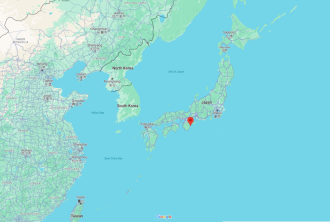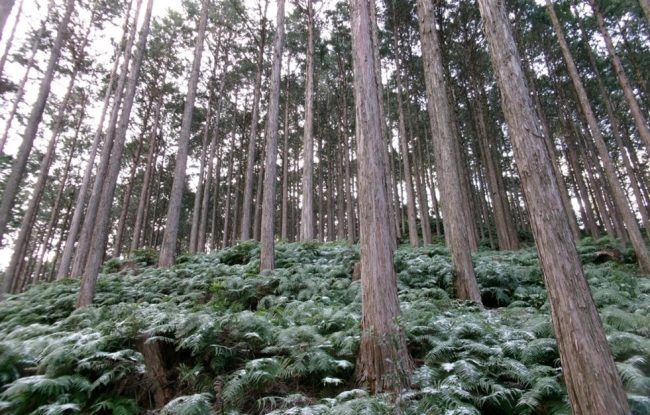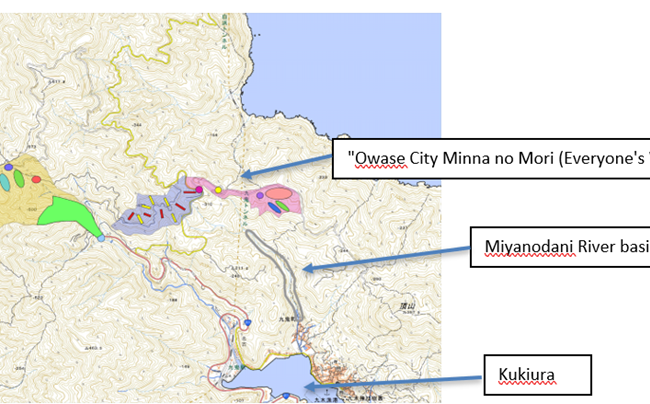A Project to Restore the Ecosystem through Integrated Management from the Mountains to the Sea in Kuki Area, Owase City
03.09.2024
SUBMITTING ORGANIZATION
Owase City
OTHER CONTRIBUTED ORGANISATIONS
LY Corporation,
MITSUWA HOLDINGS CO., Ltd.,
Paramita, Inc.,
SEA VEGETABLE COMPANY,
Yamanari Co., Ltd.,
The Nature Conservation Society of Japan
DATE OF SUBMISSION
3 September 2024
REGION
Asia
COUNTRY
Japan
KEYWORDS
forestry; ecosystem restoration; traditional knowledge; biodiversity; multi-stakeholder participation
AUTHORS
Tatsuya Ishikawa, Agriculture, Fisheries & Forestry Division, Owase City, Mie Prefecture
a. Background
Owase City, with an area of 192.71 km2 and a population of 14,934 (estimated population as of November 1, 2023), is located in the southern part of Mie Prefecture in the central part of the Japanese archipelago and is one of the rainiest areas in Japan (average annual rainfall 3,800 mm)(Fig.1). The distance from the mountains at an altitude of 1,000 to 1,400 meters to the coast is short, approximately 10 to 15 kilometers, with steep slopes extending into the sea.
Forestry has been one of the main industries in the area since the Edo period, as well as fisheries, mainly set-net fishing and aquaculture. The city’s economy stagnated with the decline of the forestry industry in Japan in recent years, and a thermal power station was brought to the city in 1964 which supported the city’s economy, but ceased operation in 2018 (Fig.2).
This marked a turning point toward a city development based on primary industry once again. Currently, the city is working toward achieving zero carbon and Nature Positive, to create a society where nature and people live in harmony(Fig.3).
-
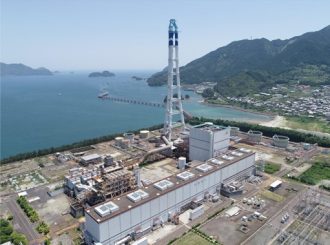
- Figure 2: Picture of Owase-Mita Thermal Power Station which decommissioned in 2018.(ref: Owase SEA Model https://www.owase-seamodel.jp/status )
-
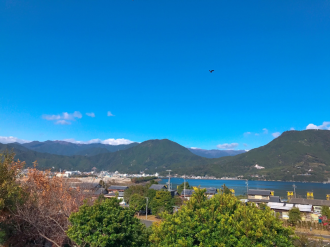
- Figure 3: View of Owase Bay and the urban area. Cleared lot in the center left is where the Chubu Electric Power Owase-Mita Thermal Power Station once stood.
b. Socioeconomic, environmental characteristics of the area
The geography of Owase City consists of mountainous area with an elevation of 1,000 to 1,400 meters, and the coastline is a complex rias coastline. Villages located deep in the inlets have been engaged in forestry, fishing, and agriculture, utilizing the ecosystem from the mountains to the sea.
The nature of the soil is predominantly granite with poorly developed soils. As a result, the soil fertility has decreased due to years of forestry operations, and many areas are now unsuitable for forestry. The forest lands are becoming increasingly degraded, which is a concern in terms of disaster prevention. At the same time, biodiversity is being lost due to degradation of forest floor vegetation.
There are few pristine natural environments left in Owase, including the sea, and almost the entire area is a Satoyama and Satoumi environment. Among primary industry workers, there are still skills, traditional knowledge, and experiential knowledge for sustainable use of local nature.
Owase Hinoki has dense annual rings and is rich in oil and fat, and its hardness, strength, and reddish luster has made it one of the nation’s leading brands of lumber for post, and it has also boasted the highest production volume in Japan. However, with the liberalization of lumber imports in the 1960s, the use of domestic lumber began to decline, and combined with changes in housing styles, demand for domestic post lumber has plummeted, and the Owase Hinoki forestry industry has declined along with this trend.
Owase City’s forestry management is characterized by the large area occupied by privately owned forests and the large number of small-scale operators. As the industry heads toward decline, it is difficult for small-scale operators with weak capital to continue forestry operations. The steepness and thin soil, coupled with a decline in soil fertility and increased feeding damage by Japanese deer, have led to an increase in abandoned forests and neglect of land after clear cutting, creating problems that have a negative impact on biodiversity.
c. Objective and rationale
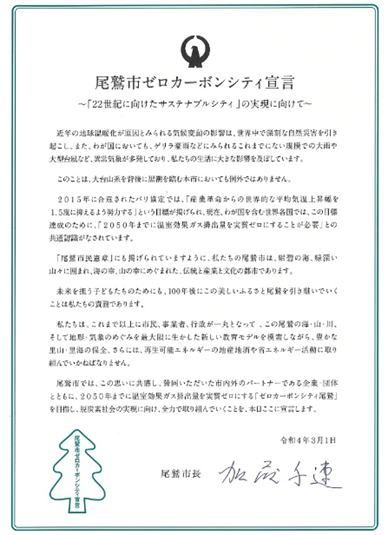
In 2022, Owase declared itself a Zero Carbon City, and in the same year, the perspective of a decarbonized society was incorporated in the Seventh Owase City Comprehensive Plan (2022-2031) (Fig.4). Furthermore, in the Third Owase City Environmental Basic Environment Plan formulated in 2023, the city stated its goal of becoming a “Nature Positive Community”. Based on these plans, Owase is promoting initiatives for Just Transition, to a society where nature and people live in harmony, with the aim of achieving zero carbon and Nature Positive.
d. Detailed description of activities
Efforts to Restore the Ecosystem in “Owase City Minna no Mori (Everyone’s Woodland)”
“Owase City Minna no Mori (Everyone’s Woodland)” refers to a portion of an approximately 91-hectare area of planted forest, mainly Owase Hinoki and Japanese cedar, near the top of Itadakiyama in Kuki-cho, Owase City, among the municipal forests managed and owned by the city (Fig.5) (Fig.6).
“Owase City Everyone’s Woodland” has been promoting efforts to promote forest growth and rejuvenation in order to increase the forest’s carbon dioxide absorption. From FY2022, in some areas, in order to improve the subsoil environment, soil improvement which had become a gleysol due to years of forestry operations and restoration of water veins focusing on the oxygen and water cycle in the soil were carried out. The restoration used spatial arrangement design and techniques based on traditional Japanese garden management techniques. In FY2023, soil improvement within the planted forest using similar techniques was expanded to adjacent areas, and information gathering and research studies were introduced to formulate a plan for ecosystem restoration throughout the “Owase City Everyone’s Woodland”.
Specifically, we conducted a mammal survey using camera traps to determine the presence of deer and other herbivores that affect vegetation.
In addition, the Kuki area is where set-net fishing using fish-breeding forests along the coast has flourished, and the local community is still partially responsible for the management of the forests and the set-net fishing operation. The local people have managed and used the area from the mountains to the sea as an integral part of a typical Satoyama and Satoumi. In this project, we will work with the local community to restore forests, rivers, Satochi, and marine areas by utilizing the traditional and experiential knowledge of the local community and incorporating new scientific verification.
Efforts to conserve and restore biodiversity in marine areas
Fishing is an important industry, but in a 1999 research survey, rocky-shore denudation was confirmed in Haidaura. The main reason was presumed to be feeding damage by Diadema spp., a species of sea urchin. Therefore, the city took the lead in initiating activities to conserve and restore the seaweed beds by removing sea urchins in FY 2009. Currently, removal activities are being conducted in four ocean areas: Owase Bay, Kukiura, Haidaura, and Mikiura, and as of year 2023, 16.1 hectares of seaweed beds have been restored.
In addition, the decline of the bigfin reef squid (Sepioteuthis lessoniana), the region’s representative fisheries species, has also become an issue. In 2005, the city began installing spawning beds for bigfin reef squid using thinned cypress wood. Currently, a total of over 100 spawning beds have been installed at three diving spots in the city and in the districts of Sugari, Owase, Osone, Yukunoura, Kuki, Haida, Mikiura, Furue, Soneura, and Kajika (Fig.7). Efforts to utilize thinned wood from local mountains in the local sea, which also leads to resource circulation, have been ongoing for more than 15 years.
In the future, through forest and river restoration, the project aims to further restore the area by improving the seafloor environment, managing the amount of sediment inflow, and securing biological migration routes between land and sea.
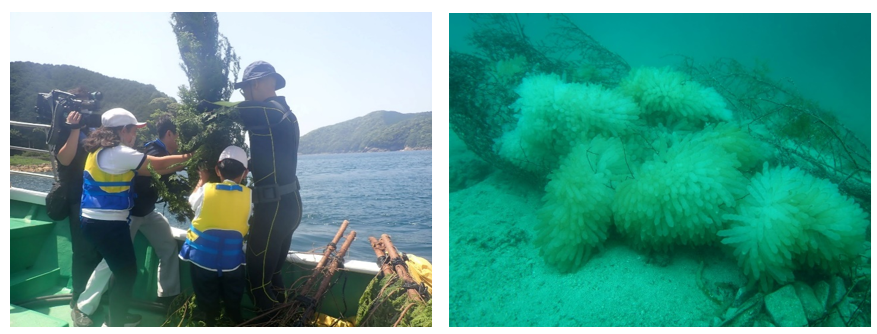
The relationship between the above efforts and the “six ecological and socio-economic perspectives” of the Satoyama Initiative
As stated in the “Owase City Organic Village Declaration,” forestry, fisheries, and agriculture are all to be carried out within the carrying capacity and resilience of the environment 1). Therefore, while maintaining and succeeding to the traditional Owase Hinoki forestry 3), the aim is to shift the forestry operations in the low fertile forest areas to secondary forests where broadleaf trees take precedence, and in the future, to forests that can be called natural forests. This will also contribute to the restoration of biodiversity unique to the region. Furthermore, it aims to restore the continuity of the mountains, rivers, and oceans, so that materials or resources can be used in a cyclical manner 2). In addition, these efforts are not only intended to prevent global warming and conserve biodiversity, but also to address the challenges facing local communities, such as how to establish sustainability amidst a continuing population decline, depopulation, and aging society, with steep terrain in most of the city areas 5) 6). In order to realize these goals, the project is being carried out in collaboration with diverse entities, including Owase City, forestry, fishermen, farmers, other citizens, researchers, NGOs, and businesses 4).
* The numbers in the above text correspond to the “six ecological and socioeconomic perspectives” of the Satoyama Initiative below.
1) Resource use within the carrying capacity and resilience of the environment,
2) Cyclic use of natural resources,
3) Recognition of the value and importance of traditions and cultures,
4) Multi-stakeholder participation and collaboration in sustainable and multi-functional management of natural resources and ecosystem services,
5) Contributions to sustainable socio-economies including poverty reduction, food security, sustainable livelihood and local community empowerment, and
6) Improved community resilience to achieve multiple benefits through ecosystem-based approaches.
e. Results and lessons learned
Efforts to restore ecosystems in forests
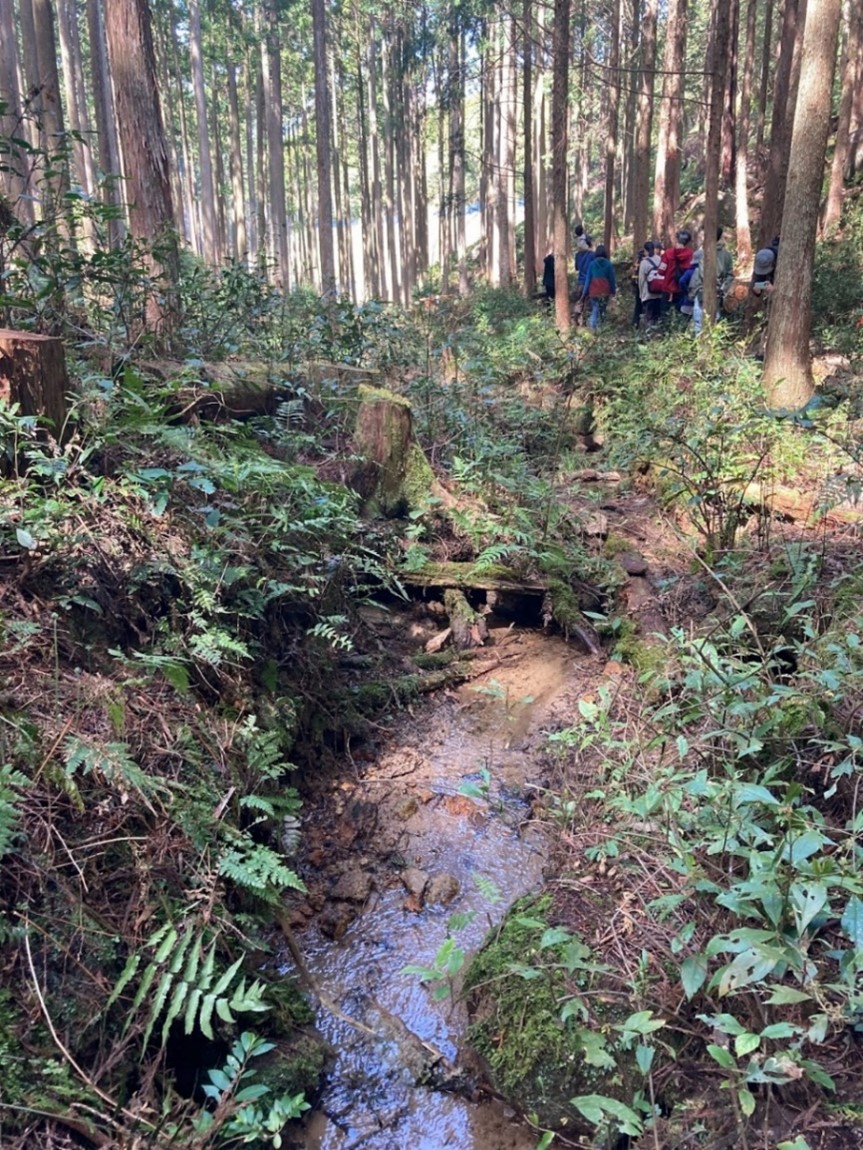
To date, 7.25 hectares of forest in “Owase City Everyone’s Woodland” have been logged and planted to rejuvenate forests, which carbon dioxide absorption has declined due to aging forests. In addition, the forest floor has been maintained in consideration of soil and subsoil water, and some water veins were restored in FY2022 (Fig.8).
In 2024, we plan to work on the improvement of the subsoil environment and the restoration of water veins in “Owase City Everyone’s Woodland,” environmental restoration in downstream rivers, and the restoration of seaweed beds in the marine area and the development of indicators to measure the impact from land areas.
In addition, depending on land fertility, studies are underway to continue Japanese cypress plantations or to convert the land to broadleaf forests with the aim of restoring it to natural vegetation. Conversion of land unsuitable for forestry to broadleaf forests will gradually develop understory vegetation, protect the soil from erosion, and lead to the formation of good forest soil. For this reason, a vegetation survey will be conducted to clarify the broadleaf forests to be aimed for and to examine methods for their formation. The relationship between vegetation and topography・nature of the soil and the animal communities that each vegetation support will also be outlined.
OECM(Other effective area-based conservation measures): Efforts toward registration
In order to contribute to 30by30 and to conserve biodiversity, 94 sites were selected as candidates for OECM certification for the entire Owase City area, including marine areas. Of these, 28 sites were within protected areas and 66 sites were outside protected areas, with approximately 70% of the sites located outside protected areas. The areas with the largest number of sites were the Tenma and Kuki areas, with 10 sites, followed by Mukai, Mikiura, and Mikisato, with 8 sites. Of the areas with a concentration of sites, all of the sites in the Tenma, Mukai, and Mikisato areas were located outside of protected areas. These are all where agriculture is practiced.
Of the sites selected, 27 were located in marine areas and 8 sites straddling land and marine areas, which include islands, sandy beaches, and coastal vegetation. The marine sites have ongoing monitoring and environmental restoration activities and may be strong candidate sites when OECM accreditation requirements are finalized (Fig.9).
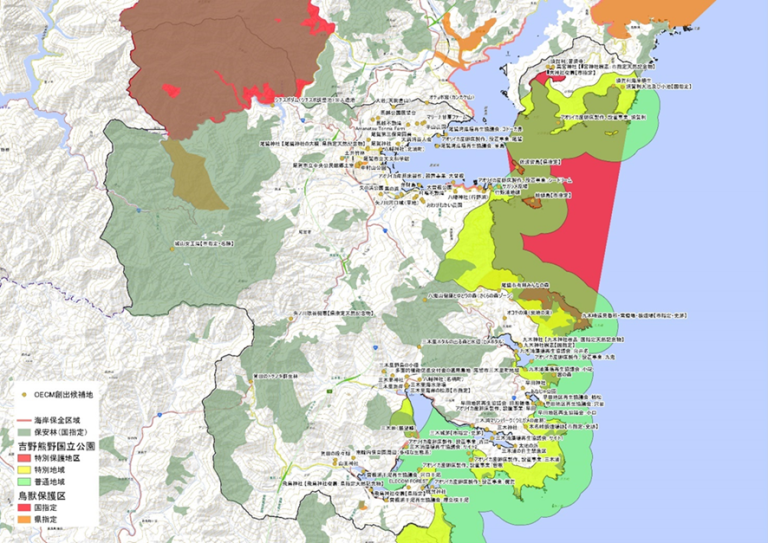
Funding
We have been maintaining our activities through donations from corporations using the “corporate version of hometown tax program mechanism, “Kigyoban Furusato Nozei”. However, since the donations under this tax program are applied for every single fiscal year, it is a challenge to receive continuous donations, and there is no plan for donations for FY2025 and beyond, making it difficult to secure funding. Forestry operations are currently funded by taxes, and it is difficult for small municipalities to secure the budgets. In order to make this an ongoing activity, we would like to take the challenge for creating new values for forests (recreational use, sale of standing timber to individuals, forest rentals, etc.). In addition, we would like to collaborate not only with companies, but also with the national government, individuals, and various other sectors in Japan and overseas, in order to develop new sales channels and create added value.
f. Key messages
Starting with the “Owase City Everyone’s Woodland”, Owase City aims to create new environmental values in primary industries and to sustain and develop them in conjunction with the local economy through environmental restoration efforts that contribute to carbon neutrality and creating forest rich in biodiversity, river restoration, and biodiversity conservation and restoration of marine areas.
Kuki-cho, as a Satoyama, will show the creation of a living area that contributes to the restoration of the ecosystem, together with a wide range of local residents, people involved in primary industries, schools, and other educational institutions, and will be expanded through workshops and other means to develop human resources. We hope to use this project as a model for “Nature Positive Community Development” that continues on to the 22nd century.
References and bibliography
・Ishikawa T, Taiki T, Abe M, Iwao T, Morita T, Maegawa M, Kurashima A.(2017) Change in algal flora by removing Diadema in Haidaura Bay, Mie Prefecture. Nippon Suisan Gakkaishi, 83(4):599-606.(in Japanese with English abstract).
・Owase Region Wildlife Survey Group, Mie Prefecture Natural Science Research Society (Owase chousakai・Mie-ken shizenkagaku kenkyukai-hen) (1982). Report of the research on fauna and vegetation of Owase District in Mie Prefecture, 575pp. (in Japanese)
・Owase Forestry Policy Promotion Council (Owase rinsei suisin kyougikai) (2019). Japanese Agricultural Heritage: Owase Hinoki Forestry created by steep terrain and heavy rainfall (Kyushun na chikei to nihon yusuu no tau ga umidasu nihon nougyou isan Owase Hinoki ringyou), 57pp. (in Japanese)
・Mie Prefecture Environmental Conservation Agency, ed. (1981). Owase Environmental status survey report(summary)( Owase chiiki ni okeru kankyou genjyou houkokusyo (summary) ),160pp. (in Japanese)
・Miyashita M, Noda T.(2003). Community Ecology (Gunsyu seitai gaku),200pp.(in Japanese)
・Forestry Agency, Japan, ed.(2021). Guidelines for Forest Management Considering Biodiversity Conservation (Seibutsu tayousei no hozen ni hairyo shita shinnrin segyou no tebiki), 96pp.(in Japanese)
Web links of any relevant organizations and projects
LY Corporation
https://www.lycorp.co.jp/en/
MITSUWA HOLDINGS CO., Ltd.
https://mhdg.co.jp/(Japanese)
Paramita, Inc.
https://paramita.co.jp/(Japanese)
SEA VEGETABLE COMPANY
https://seaveges.com/en
Yamanari Co., Ltd.
The Nature Conservation Society of Japan
https://www.nacsj.or.jp/english/
Author’s profile(s)
Tatsuya Ishikawa is a fisheries engineer at Owase City Office and specializes in physiological ecology. With a lifelong interest in living organisms, his research focuses on seaweed bed restoration through removal of Diadema spp. He balances his city office duties with weekend research, contributing to local and regional ecological studies.


